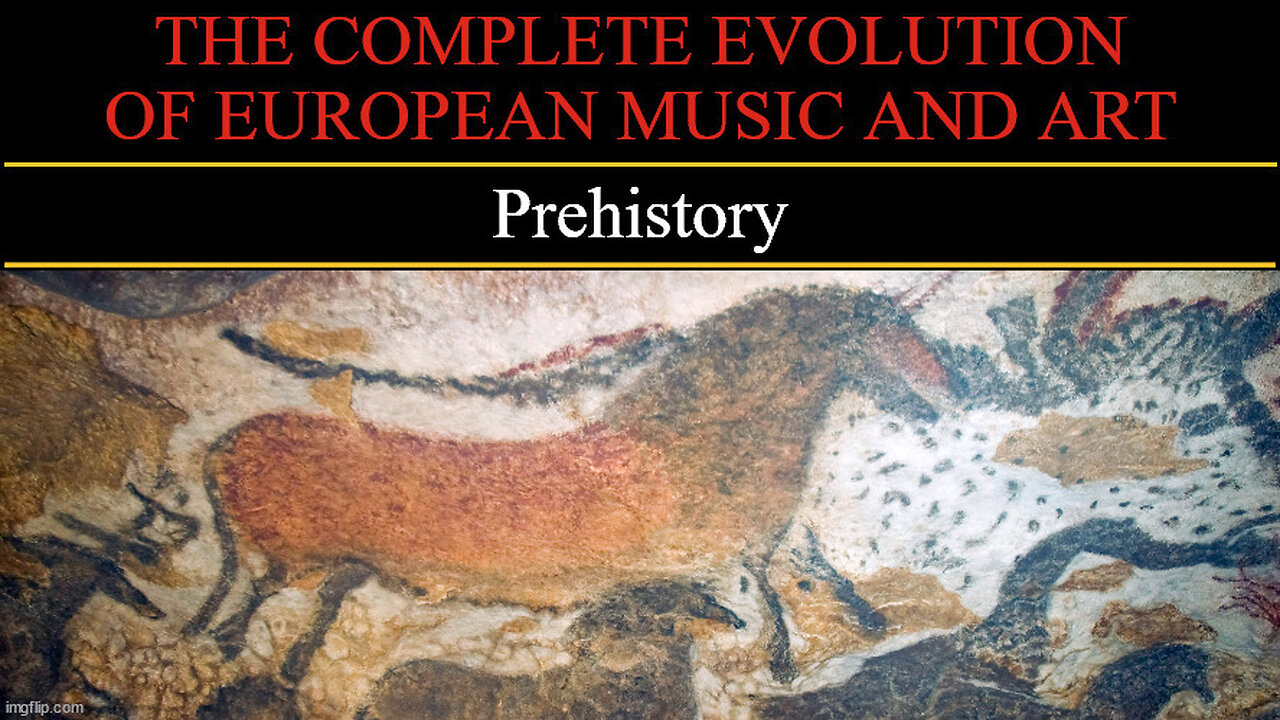Premium Only Content

Timeline of European Art and Music - Prehistory
Timestamps
0:00 - Various bird songs at a pond in Germany.
1:03 - Sound of fire
3:12 - Beech Forest of Germany in Spring
4:09 - European Robin
4:38 - 1,600,000 BC - English - Stone handaxe
5:08- Common Redstart
5:38 - 400,000 - 200,000 BC - Central Europe - Stone tools found in a neanderthal flint workshop discovered in Poland
6:08 - Sparrowhawk
6:45 - Rock Dove mating call
7:16 - 80,000 - 40,000 BC - French - An Aurignacian blade shown from three angles. Named for the French village of Aurignac, where prehistoric remains were discovered in a cave in 1860, the Aurignacian culture is associated with th
7:46 - Eurasian Collared Dove
8:39 - Male Collared Dove Calling To Female
9:11 - 50,000-60,000 BC - Neanderthal - Divje Babe flute
10:11 - 35,000 - 40,000 BC - German - Venus of Hohle Fels
11:11 - Inhabited 40,000-30,000 BC - Potočka zijalka cave
11:41 - 42,000 - 43,000 BC - German cave - Flutes made of mammoth tusks.
12:41 - 42,000 - 43,000 BC - German cave - Flute made of bird bone.
13:41 - 35,000 - 40,000 BC - German - Bird bone flute - The oldest known human flute, from Hohle Fels Cave in Germany. A thin bird-bone flute carved from a Griffon Vulture
14:11 - Inhabited 40,000 BC - German - Hohle Fels Cave, entrance
14:41 - Inhabited 40,000 BC - German - Hohle Fels Cave, interior
15:11 - Eurasian Teal
15:48 - 35,000 - 40,000 BC - German - Lion-Human of Hohlenstein-Stadel
16:18 - Greylag Goose
16:52 - 35,000 - 40,000 BC - German - Adorant from the Geißenklösterle cave
17:22 - Inhabited 30,000 - 12,000 BC - Brillenhöhle cave - More of the path leading to the cave
17:52 - Inhabited 30,000 - 12,000 BC - Brillenhöhle cave - Path leading to the cave
18:22 - Common cuckoo
18:57 - Inhabited 30,000 - 12,000 BC - Brillenhöhle cave - Entrance of the cave.
19:27 - Barn swallow
19:57 - Inhabited 30,000 - 12,000 BC - Brillenhöhle cave
20:27 - Green woodpecker
20:50 - Inhabited 30,000 - 12,000 BC - Germany - Path from Brillenhöhle to Geißenklösterle - The 'Kissing Sow' rock formation in the top left
21:20 - Red Back Shrike
21:50 - Inhabited 30,000 - 12,000 BC - Germany - Path from Brillenhöhle to Geißenklösterle
22:20 - Cicada orni
22:48 - Inhabited 30,000 - 12,000 BC - Germany - Geißenklösterle cave entrance.
23:18 - Common frog
23:55 - 35,000-11,000 BC - Spain - Cave of Altamira painting - Bison
24:25 - Mole cricket
24:55 - 35,000-11,000 BC - Spain - Cave of Altamira painting
Bison on the roof of the pit
25:25 - Black forest thunderstorm
25:55 - Fireflies, also called Lightning bugs
27:40 - Fireflies, also called Lightning bugs
28:10 - Tawny owl
28:46 - 32,000 BC - French - Cave Hyena - Found in the Chauvet cave.
29:16 - Black Forest of Germany in Autum with mist
29:50 - Black Forest of Germany in Autum with mist
30:57 - Lightning over nothern Italy
33:25 - Rainbow in German alps
33:55 - Rainbow in Val Camonica, Italy.
34:25 - 20,000 BC - French - Lascaux Cave paintings - Horses
34:55 - A walk through the Black Forest of Germany in autum
36:54 - 20,000 BC - French - Lascaux Cave paintings - more horses
37:24 - A walk through the Black Forest of Germany in autum
37:55 - 20,000 BC - French - Lascaux Cave paintings - Hall of the Bulls
38:25 - 20,000 BC - French - Lascaux Cave paintings - aurochs (extinct species of large wild cattle)
38:55 - Blizzard in the Netherlands
39:55 - 20,000 BC - French - Lascaux Cave paintings - a man with a bird head and a bison
40:25 - A walk through the Black Forest of Germany in winter
40:56 - 20,000 BC - French - Lascaux Cave paintings - A dun horse
41:26 - Grey Wolves in Germany (domesticated 33,000-15,000 BC)
41:56 - 20,000 BC - French - Lascaux Cave paintings - Megaloceros with line of dots
42:26 - A walk through the Black Forest of Germany in winter
43:00 - A walk through the Black Forest of Germany in winter
43:17 - Aurora Borealis in Norway (footage not sped up)
44:16 - Blue Tit
44:45 - 15,000-13,000 BC - French - Bison Licking Insect Bite
45:15 - Great Tit
45:45 - 12,500 BC - Russian - Kapova Cave Paintings - Red-Ochre Painting of Mammoths
46:15 - European Starling
46:46 - 12,000 BC - Central Europe - Jadeite axe
47:16 - European Goldfinch
47:47 - 17,000 - 11,000 BC - Western Europe - Bone tools
48:17 - Winter's survivors emerge in the spring to pass themselves into the future through their children.
-
 LIVE
LIVE
Steven Crowder
2 hours ago🔴Game Over: Trump's EU Trade Victory Shows How Stupid "Experts" Really Are
57,305 watching -
 LIVE
LIVE
The Rubin Report
38 minutes agoMajor Company’s Must-See Ad May Be the Official Death of Woke
1,925 watching -
 31:47
31:47
VINCE
2 hours agoWhat Just Happened With Obama? (w/ Sean Davis) | 07/25/25
48K106 -
 LIVE
LIVE
LFA TV
15 hours agoLFA TV ALL DAY STREAM - MONDAY 7/28/25
4,954 watching -
 1:14:21
1:14:21
Dear America
2 hours agoBongino Confirms The TRUTH!! Says He’ll “Never Be The Same” 👀 + JD 2028?!
100K170 -
 LIVE
LIVE
Caleb Hammer
1 hour agoScumbag Husband Destroys Marriage With Secret Debt | Financial Audit
81 watching -
 LIVE
LIVE
Badlands Media
9 hours agoBadlands Daily: July 28, 2025
5,862 watching -
 LIVE
LIVE
JuicyJohns
2 hours ago🟢#1 REBIRTH PLAYER 10.2+ KD🟢 !loadout
109 watching -
 LIVE
LIVE
Wendy Bell Radio
6 hours agoDemocrats Are As Fake As Russian Collusion
9,634 watching -
 48:34
48:34
Randi Hipper
1 hour agoBITCOIN TAKES OVER WALL STREET AS IT NEARS ALL TIME HIGHS
6.28K